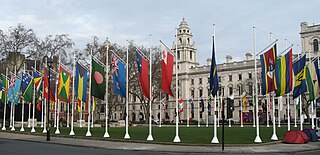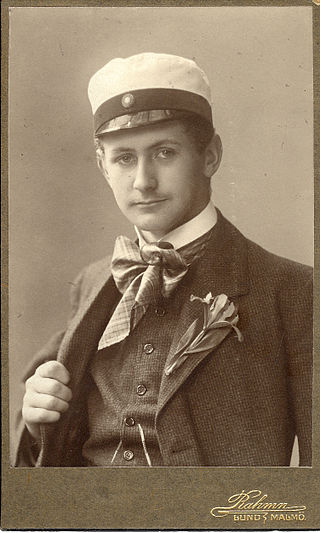
August is the eighth month of the year in the Julian and Gregorian calendars. Its length is 31 days.

A holiday is a day or other period of time set aside for festivals or recreation. Public holidays are set by public authorities and vary by state or region. Religious holidays are set by religious organisations for their members and are often also observed as public holidays in religious majority countries. Some religious holidays, such as Christmas, have become secularised by part or all of those who observe them. In addition to secularisation, many holidays have become commercialised due to the growth of industry.
July is the seventh month of the year in the Julian and Gregorian calendars. Its length is 31 days. It was named by the Roman Senate in honour of Roman general Julius Caesar in 44 B.C., being the month of his birth. Before then it was called Quintilis, being the fifth month of the calendar that started with March.

The national flag of Finland, also known in Finnish as the Siniristilippu, dates from the beginning of the 20th century. On a white background, it features a blue Nordic cross, which represents Christianity.

By an ordinance issued by the government of Sweden, a number of days of the calendar year are designated as official flag flying days when the Swedish flag is flown on all public flagpoles and buildings. Hoisting of the Swedish flag on private flagpoles on these days is strongly encouraged but not mandatory.

The National Day of Sweden is the national day of Sweden, observed annually as a public holiday on 6 June. Prior to 1983, the day was celebrated only as the Swedish Flag Day. It was officially named the Swedish National Day by the parliament of Sweden in 1983, and became a public holiday in 2005. The day is celebrated in honor of the election of Gustav Vasa as King of Sweden in 1523 and of the adoption of the constitutions of 1809 and 1974.

Midsummer is a celebration of the season of summer, taking place on or near the date of the summer solstice in the Northern Hemisphere; the longest day of the year. The name "midsummer" mainly refers to summer solstice festivals of European origin. In these cultures it is traditionally regarded as the middle of summer, with the season beginning on May Day. Although the summer solstice falls on 20, 21 or 22 June in the Northern Hemisphere, it was traditionally reckoned to fall on 23–24 June in much of Europe. These dates were Christianized as Saint John's Eve and Saint John's Day. It is usually celebrated with outdoor gatherings that include bonfires and feasting.
All official holidays in Finland are established by acts of Parliament. The official holidays can be divided into Christian and non-Christian holidays. The main Christian holidays are Christmas, New Year's Day, Epiphany, Easter, Ascension day, Pentecost, Midsummer Day, and All Saints' Day. The non-Christian holidays are May Day and the Independence Day of Finland.

Flag Day is a holiday celebrated on June 14 in the United States. It commemorates the adoption of the flag of the United States on June 14, 1777 by resolution of the Second Continental Congress. The Flag Resolution stated "That the flag of the thirteen United States be thirteen stripes, alternate red and white; that the union be thirteen stars, white in a blue field, representing a new constellation."

Flag flying days in Finland are days of the year when the national flag is flown nationwide, either by law or by custom. The flag of Finland is generally flown only on special occasions to celebrate or honour someone or something. On certain days of the year the state officially flies the flag, and recommends all private citizens to do so as well, these are the flag flying days as listed below. Any citizen has a right to fly the flag on their own property if they deem it appropriate, for example in celebration of birthdays or weddings in the family. Midsummer's day is additionally celebrated as Flag Day in Finland.

A national day is a day on which celebrations mark the statehood or nationhood of a state or its people. It may be the date of independence, of becoming a republic, of becoming a federation, or a significant date for a patron saint or a ruler.

Commonwealth Day is the annual celebration of the Commonwealth of Nations, held on the second Monday in March. While the date holds some official status in select member states of the Commonwealth, observances of the date are not uniform across the Commonwealth, and the date is not celebrated as a public holiday in most Commonwealth countries.
Public holidays in South Korea each belong to one or more of three categories:

Constitution Day is the national day of Norway and is an official public holiday observed on 17 May each year. Among Norwegians, the day is referred to as Syttende mai, Nasjonaldagen, or Grunnlovsdagen, although the latter is less frequent.

Saint Andrew's Day, also called the Feast of Saint Andrew or Andermas, is the feast day of Andrew the Apostle. It is celebrated on 30 November. Saint Andrew is the disciple in the New Testament who introduced his brother, the Apostle Peter, to Jesus, the Messiah.
A flag day is a flag-related holiday, a day designated for flying a certain flag or a day set aside to celebrate a historical event such as a nation's adoption of its flag.

Independence Day is a national public holiday in Finland and a flag flying day held on 6 December to celebrate Finland's declaration of independence from Russia after the Bolsheviks took power in late 1917.

Swedish festivities are an integral part of Swedish culture, reflecting the country's history, traditions, and seasonal changes. These celebrations range from religious observances to secular holidays, and often incorporate unique customs and foods. Major festivities include Midsummer, Christmas (Jul), Easter (Påsk), and Walpurgis Night (Valborg), Semel day. Many Swedish festivities are closely tied to the Lutheran Church of Sweden, although participation in religious services has declined in recent years. The celebration of these holidays often involves specific rituals, traditional foods, and gatherings with family and friends, contributing to the social fabric of Swedish society.
In Sweden, public holidays are established by acts of Parliament. The official holidays can be divided into Christian and non-Christian holidays. The Christian holidays are jul (Christmas), trettondedag jul (Epiphany), påsk (Easter), Kristi himmelsfärds dag, pingstdagen (Pentecost), and alla helgons dag. The non-Christian holidays are: nyårsdagen, första maj, Sveriges nationaldag, and midsommar (Midsummer). Midsummer is, however, officially also a Christian holiday to celebrate John the Baptist's birthday.

The Victoria Days, earlier: Victoria Day, is an annual celebration in Sweden in mid-July to celebrate Crown Princess Victoria's birthday.














